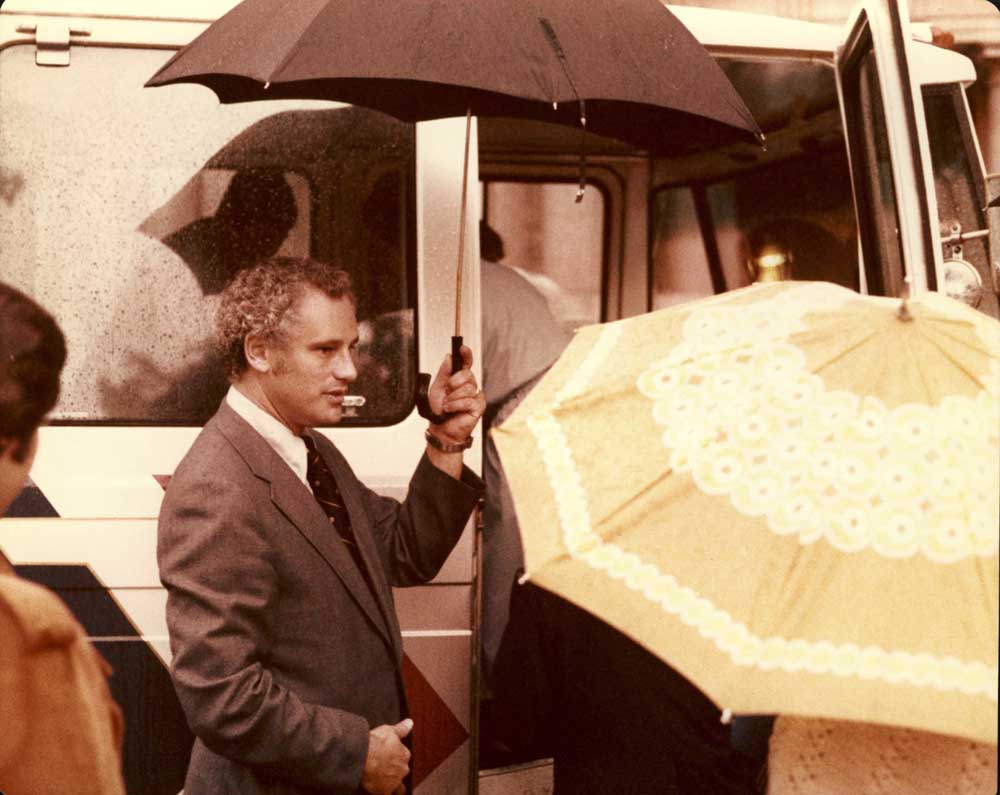Neil Goldschmidt, former Oregon governor who sexually abused teen, dead at 83
Published 5:39 pm Wednesday, June 12, 2024

- A 1977 photo from the City of Portland's archives shows Neil Goldschmidt, then mayor, holding an umbrella.
Neil Goldschmidt, whose years as Portland mayor, U.S. transportation secretary and Oregon governor will be forever shadowed by his sexual abuse of a young girl, has died.
Trending
His family confirmed Wednesday, June 12, that he died of heart failure four days shy of his 84th birthday.
When he withdrew from public life in 2004, after news disclosures by Willamette Week that he had had sex more than once with an underage girl while mayor in the 1970s, Goldschmidt said he was in poor health and had been to the Mayo Clinic. (The news coverage earned Willamette Week and Nigel Jaquiss a Pulitzer Prize in 2005.)
Goldschmidt’s public admission of his abuse of the girl — he said she was 14, but she said later she was 13 — was well past the three-year statute of limitations for prosecution. He was never charged with a crime for third-degree rape, which applied to victims under age 16.
Trending
Goldschmidt suffered a stroke at age 72 in 2012.
Goldschmidt was a Legal Aid lawyer in 1970, when he was elected to the Portland City Council. Two years later, at age 32, he was elected mayor. He and his council allies advocated initiatives, such as the downtown Transit Mall and a light-rail alternative to the proposed Mount Hood Freeway, that transformed Portland from just another American city to a modern metropolis less dependent than others on automobiles.
While others were in the forefront of the anti-freeway movement in the 1970s — notably Earl Blumenauer, then a young state representative and later a Multnomah County commissioner — Goldschmidt as mayor stood with them in his re-election victory over Commissioner Frank Ivancie in 1976. (Ivancie was elected mayor in 1980, when he defeated Connie McCready, but lost to Bud Clark in 1984.)
His transportation work attracted the attention of President Jimmy Carter, who appointed Goldschmidt U.S. secretary of transportation in 1979, at the same time Carter appointed New Orleans Mayor Moon Landrieu to another Cabinet post.
When Carter lost re-election and left the presidency in 1981, Goldschmidt joined sportswear giant Nike as vice president for international marketing and later as president of Nike Canada.
But Goldschmidt re-entered the political arena when he was elected governor in 1986, shortly after TriMet’s first light-rail segment opened from Portland to Gresham. Some of the federal money for it came from the now-defunct freeway project.
He succeeded two-term Republican Vic Atiyeh, who could not run again, and began the longest unbroken run of governors under a single party in Oregon’s history. Only Democrats have been elected governor since 1986.
His victory over Republican Norma Paulus, a former secretary of state, was by 52% to 48%.
He was the only Oregon governor of 16 since World War II, counting John Kitzhaber only once, without prior experience in state government.
His campaign program, “The Oregon Comeback,” drew together state agencies and local communities to devise ways to revive the state’s economy as it was emerging from a seven-year downturn. Lawmakers from both parties generally embraced it in his first year.
Goldschmidt had Democratic legislative majorities for both cycles during his term, rare among recent governors, though Democrat Kate Brown inherited her majorities when she became governor in February 2015.
He attempted to spell out a “children’s agenda” as a follow-up program, but was only partly successful. He presided over a rapid expansion of the state prison system and hired Michael Francke from New Mexico to oversee it, but Francke was murdered outside the Department of Corrections offices in Salem in 1989.
Records from the time show Goldschmidt opposed the FBI investigating the crime. A low-level Salem criminal named Frank Gable was convicted of the murder in 1991 but exonerated by two federal courts nearly 30 years later.
Goldschmidt was facing a vigorous challenge to re-election from Attorney General Dave Frohnmayer, the likely Republican nominee. But he was widely considered to have a good shot at winning again when he announced suddenly in 1990 that his marriage to Margaret “Margie” Wood was breaking up — and that he was withdrawing his candidacy. They had two children, Joshua and Rebecca.
As a governor who chose not to seek re-election, Goldschmidt was able to broker a compromise overhaul of Oregon’s system of compensating workers injured on the job — a system faulted for its high premiums for employers and low benefits for workers. He left the details to Ted Kulongoski, the state insurance commissioner who would be elected governor in 2002, and the Legislature approved it in May 1990.
Then-Secretary of State Barbara Roberts stepped in for the Democrats and was elected governor with 46%, compared with Frohnmayer’s 39% and Al Mobley, an independent who opposed abortion, a modern record 13%.
Out of office, Goldschmidt formed his own consulting firm with his former chief of staff, Tom Imeson. His involvement in several issues, such as the 1995 legislation that made Oregon Health & Science University mostly independent of the state, drew criticism from former political allies. He also led an effort by a Texas firm to buy Portland General Electric, which former energy giant Enron sold after its bankruptcy in late 2001. But that deal never was completed.
When he took his official papers as governor and deposited them with the Oregon Historical Society, it prompted lawmakers in 1991 to require official records of the governor, secretary of state and state treasurer be retained by the State Archives. After the Willamette Week disclosures, Goldschmidt returned his official state records to the State Archives. (The 1991 law is not retroactive; Mark Hatfield’s papers are housed by Willamette University, his alma mater.)
He did follow through with the establishment of Start Making a Reader Today, a program that encourages children to read and provides volunteer readers, in 1991.
Goldschmidt had remarried — to Diana Snowden, a former vice president of PacifiCorp — when Kulongoski coaxed him back into state government as an appointee to the state Board of Higher Education, which prior to 2011 oversaw the seven state universities.
After the Willamette Week disclosures, which prompted Goldschmidt to resign from the board, he and Snowden often made visits to a home they had purchased in the south of France. They had a daughter.
Goldschmidt made a rare public appearance in 2011, when a public memorial service was held at the Capitol in Salem for Mark Hatfield, former Oregon governor and U.S. senator. He was among the four living former governors who attended but did not speak; only the incumbent governor, John Kitzhaber, spoke.
Goldschmidt had an official portrait — actually three faces — as a former governor. But legislative leaders ordered it transferred to a room not used by most Capitol visitors, and years later, it was put into storage. The latter occurred a few days after the 2011 death of Elizabeth Lynn Dunham, the woman he raped as a child, from cancer at age 49.
(The portraits began with Bob Straub, but because of seismic work at the Capitol, all of them have been put into storage.)
Goldschmidt was born June 16, 1940, in Eugene to Lester Goldschmidt and Annette Levin. He graduated from South Eugene High School, earned a bachelor’s degree in political science in 1963 from the University of Oregon, and his law degree in 1967 from the University of California at Berkeley.
He was an intern for U.S. Sen. Maurine Neuberger in 1964, and that same year, he was recruited by Allard Lowenstein — later a U.S. representative from New York — to work in Freedom Summer to educate and register Black voters in the South.
pwong@pamplinmedia.com
NOTE: Corrects a statement on the number of children by Goldschmidt with his second wife, Diana Snowden.







